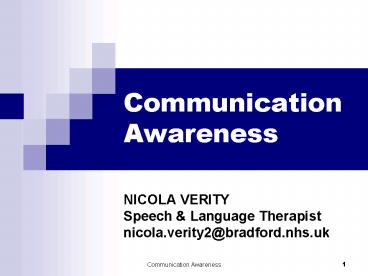NICOLA VERITY - PowerPoint PPT Presentation
1 / 22
Title:
NICOLA VERITY
Description:
Loss / impairment of language caused by damage to the brain ... and other props such as photo albums, magazines, diary/calendar, objects, maps, ... – PowerPoint PPT presentation
Number of Views:46
Avg rating:3.0/5.0
Title: NICOLA VERITY
1
Communication Awareness
- NICOLA VERITY
- Speech Language Therapist
- nicola.verity2_at_bradford.nhs.uk
2
Programme Overview
- Terminology solved
- Insight of patient perspective
- Strategies to facilitate communication
- Referrals
3
Terminology
- What are we talking about?
4
Aphasia
- Loss / impairment of language caused by damage to
the brain - It can affect understanding speech, reading,
talking and writing - Sometimes called dysphasia
- Estimated 20-30 of stroke survivors experience
aphasia - 6 months post-stroke 15 still have aphasia
- (Royal College of Physicians, 2004)
5
Dysarthria
- Difficulty with the physical production of spoken
sounds and words - Weak and slow movements of the lips, tongue, soft
palate, jaw, vocal folds and muscles for breath
support make speech unclear - Facial weakness
- Speech may sound slurred, breathy, weak,
laboured, too quiet, mumbled - Single words may be clearer
6
Verbal Dyspraxia
- Trouble programming and coordinating the muscles
required for speech in the absence of muscular
weakness - Automatic phrases may be easier
- Confrontational tasks are harder
- Trial and error and groping for sounds may be
observed - Variable
7
Possible Consequences of Communication
Difficulties
- Withdrawal from social situations
- Isolation
- Unemployment
- Loss of leisure pursuits
- Loss of friends
- Frustration
- Anger
- Upset
- Feeling stupid
- Depressed
Sarno (1997)
8
Barriers to Communication
- Emotional state
- Communication environment
- Conversation partner (s)
- Ability confidence, severity of impairment
- Lack of opportunity
9
Why do we need to know about communication
difficulties?
- Impact on the client
- Impact on family and carers
- Impact on rehab
10
What can we do?
- The purpose of communication - Why?
- The medium of communication
- - How?
11
Conversation key messages
- Being involved in good conversations can improve
confidence and quality of life - Conversation with people with communication
difficulties requires skills, behaviour changes
and resources these are techniques which
everyone can learn - Conversational success and breakdown is the
responsibility of both people
12
Adapt your style to facilitate communication!
- Supported Conversation
- Message in
- Make sure the person with aphasia has understood
- Message out
- Make sure the person with aphasia, dysarthria or
dyspraxia has opportunities to express themselves - Acknowledging competence
- Keep the conversation adult and natural, show you
acknowledge their expertise
13
Message inensuring the person with aphasia
understands
- Reduce background noise and distractions
- Use alerting signals to let the person know you
are speaking to him/her - Check the client has their glasses and hearing
aid if needed - Keep phrases short
- Make your speech less grammatically complex
- Use everyday words instead of long, complex or
abstract ones - Repeat and emphasise key words
- Write down key words
14
Message in
- Slow down but try not to be patronising
- Use pauses between words and sentences
- Have a pen and paper handy to draw or write key
ideas down - Use photos, pictures and objects relevant to the
topic youre discussing - Use gestures, body language, facial expression
and pointing to support your speech - Check that the person is following are you
with me? - Keep the conversation balanced
15
Message out..
- Quiet environment with no distractions
- Speak face to face
- Give him/her your full attention
- Be patient
- Make sure the client has a reliable way of
responding to yes/no questions e.g. pointing to
written yes/no, thumbs up/down, head nod/shake - Encourage the use of pen and paper and other
props such as photo albums, magazines,
diary/calendar, objects, maps, communication
picture chartsGather these beforehand.
16
Message out
- Encourage the use of body language, facial
expression, gestures and pointing to get their
message across - use it yourself - Get to know the persons preferences e.g. what
type of help they like and dislike - Get to know his or her communicative strengths
and encourage them - Dont interrupt or guess too soon
- Keep re-capping to check youve understood
correctly - An alphabet chart, communication book or a voice
output communication aid may be suitable
17
Conversation breakdown
- Stay relaxed and try to solve the problem
- Check if its really important
- Agree a signal to stop and move on
- Ask permission to leave until later
- Make a record of what youve learned so far and
return to this later if you have further thoughts - Dont pretend youve understood when you havent
18
Practice makes perfect
- Activity exchange messages using supported
conversation - Re-group and share
19
Referrals
- Open-referral
- In-patient referrals to SALT departments at
- SLH Tel 365220 Fax 365443
- BRI Tel 366517 Fax 366946
- Community hospitals and clients at home-
- Speech and Language Therapy
- Leeds Road Hospital
- Maudsley Street
- Bradford
- BD3 9LH
- Tel 01274 770397
- Fax 01274 363654
20
Useful contacts
- Speakability
- www.speakability.org.uk
21
Stroke Association
www.stroke.org.uk
22
- Connect
- The communication disability network
www.ukconnect.org.uk





![READ [PDF] Verity Paperback – October 26 2021 Read Book PowerPoint PPT Presentation](https://s3.amazonaws.com/images.powershow.com/10149884.th0.jpg?_=20241005125)

























